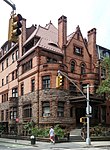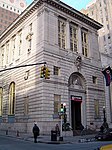Our Lady of Lebanon Maronite Cathedral (Brooklyn)
19th-century Maronite Church church buildings19th-century Roman Catholic church buildings in the United StatesBrooklyn HeightsCathedrals in New York CityChristian organizations established in 1903 ... and 8 more
Churches in BrooklynEastern Catholic cathedrals in New York (state)Eastern Catholic churches in New York (state)Lebanese-American culture in New York (state)Maronite cathedrals in the United StatesRichard Upjohn church buildingsRoman Catholic churches completed in 1846Romanesque Revival church buildings in New York City

Our Lady of Lebanon Cathedral is a Maronite Catholic cathedral located in Brooklyn, New York, United States. It is the seat of the Eparchy of St. Maron of Brooklyn. It is located in the neighborhood of Brooklyn Heights in the oldest northwest section of the borough, across the East River from Manhattan. The church building originally housed the "Church of the Pilgrims" of the old Congregational Christian Church, (merged 1957 into the United Church of Christ).
Excerpt from the Wikipedia article Our Lady of Lebanon Maronite Cathedral (Brooklyn) (License: CC BY-SA 3.0, Authors, Images).Our Lady of Lebanon Maronite Cathedral (Brooklyn)
Remsen Street, New York Brooklyn
Geographical coordinates (GPS) Address External links Nearby Places Show on map
Geographical coordinates (GPS)
| Latitude | Longitude |
|---|---|
| N 40.694230555556 ° | E -73.994205555556 ° |
Address
Our Lady of Lebanon Roman Catholic Church
Remsen Street 109
11201 New York, Brooklyn
New York, United States
Open on Google Maps







